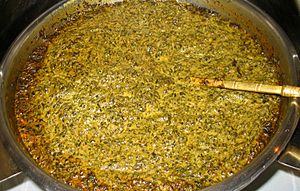Saag facts for kids

|
|
| Alternative names | Saaga or tuna (Odisha), shaag, shaak, saagwala |
|---|---|
| Region or state | Indian subcontinent |
| Main ingredients | Various kinds of edible plants |
Saag (pronounced saahg) is a popular dish from the Indian subcontinent. It is made mostly from leafy green vegetables. People usually eat saag with flatbreads like roti or naan. In some places, it is eaten with rice.
Saag can be made from many different greens. Common ingredients include spinach, mustard greens, collard greens, and even finely chopped broccoli. It is always cooked with spices and sometimes other ingredients like chhena (a type of fresh cheese).
This dish is very common in the Indian state of Odisha. There, people often eat it with pakhala (a rice dish). At the famous Shree Jagannath Temple in Puri, saag is one of the special dishes offered to the god Jagannath. Saag is also popular in West Bengal and other parts of North India. A very well-known type is sarson ka saag, made from mustard plant leaves. It is often eaten with makki ki roti, a yellow flatbread made from maize flour. Another popular dish, Saag gosht or hariyali maans, mixes spinach with mutton (sheep meat) and is common in Haryana.
Contents
What Does 'Saag' Mean?
The word saag comes from an old Indian language called Sanskrit. The Sanskrit word is shaak (śāka), which means "leafy green vegetables."
Different Kinds of Saag
Many different types of plants are used to make saag across the Indian subcontinent. Here are some of the popular variations:
Saag in Odisha
In Odia cuisine, sāga is a very important vegetable dish. It is loved all over the state. Many different plants are used to make sāga in Odisha. Some examples include:
- Kalama sāga: Made from Ipomoea aquatica, also known as water spinach.
- Kosalā/Khadā sāga: Made from amaranth leaves.
- Pālanga sāga: Made from spinach.
- Sāga chhena: This is greens, especially spinach, cooked with cottage cheese.
- Poi sāga: Made from basella leaves and soft stems.
- Bāramāsi/sajanā sāga: Made from the leaves of the drumstick tree. It can be cooked with lentils or fried onions.
- Kakhāru sāga: Made from the leaves of the pumpkin plant.
- Sorisa sāga: Made from mustard greens.
- Methi sāga: Made from fenugreek leaves.
Saag in West Bengal
In Bengali cuisine, sāg is also a very important vegetable. Many people in West Bengal eat at least one type of sāg every day for lunch. They often eat sāg that is fried or has a little gravy (called jhol) with rice. Some types of sāg found here are:
- Kalmi sāg: Made from Ipomoea aquatica (water spinach).
- Kosalā/khadā sāg: Made from amaranth leaves.
- Pālong sāg: Made from spinach.
- Puin sāg: Made from basella leaves and soft stems.
- Bāramāsi/sojnā sāg: Made from leaves of the drumstick tree.
- Kumro sāg: Made from leaves of the pumpkin plant.
- Sorshe sag: Made from mustard greens.
- Methi sāg: Made from fenugreek leaves.
Saag in Bihar
Bihar also has many types of saag. Some common ones include:
- Kalmi saag
- Munga saag
- Khesaari saag (from Lathyrus sativus)
- Poi saag (from Basella alba)
- Palak saag (Spinach)
- Bathua saag (from Chenopodium album)
- Methi saag (Fenugreek)
Saag in Jharkhand
About 70 different kinds of saag grow in Jharkhand. Some of these are:
- Beng saag
- Bhaji saag
- Kalmi saag
- Khesari saag
- Methi saag
- Munga saag
- Palak saag
- Poi saag
Saag in Uttarakhand
Leafy greens, or saags, are a key part of the food in Garhwal, Kumaon, and Jaunsari cuisine in Uttarakhand. This state has many greens because of its rich soil and forests. While Sarson (mustard), Palak (spinach), and Mooli (radish) saags are common, some unique ones are:
- Kandali saag: Also called Bicchu ghas ka saag, this is made from stinging nettle leaves. These wild plants can itch if touched, but when boiled and cooked with ghee and tomato, they are very nutritious.
- Lingdi ka saag: Made from soft fern leaves.
Saag in Haryana
- Saag gosht or Hariyali Maans is a version of saag that includes meat, usually mutton or lamb. This dish is very common in Haryana. The meat is often cooked in a special clay oven called a Bhatthi before being mixed with the other ingredients.
- In winter, saags made from Channa/Cholia (chickpea leaves), Sarson (mustard), Methi (fenugreek), Palak (spinach), and Bathua (chenopodium) are often cooked in Haryanvi homes. These saags are usually eaten with millet breads like Makki ki roti and Bajra ki roti, often with ghee or butter on top.
Saag in Punjab
- In Punjab, saag is most often made with mustard leaves. However, in other parts of the world, spinach is a common choice. Saag is usually served hot, often with chapati, makki ki roti, or bajra ki roti, and topped with clarified butter (ghee).
See also
 In Spanish: Saag para niños
In Spanish: Saag para niños



